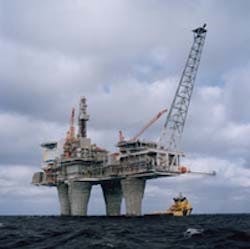New Troll platform tops North Sea action
Troll East gas platform is the world's tallest and heaviest at 430 m high and 1.05 million metric tons. Yet it is little more than a giant wellhead platform, with gas transported via pipeline to shore at Kollsnes terminal and production controlled from shore. Norsk Hydro AS recently disclosed plans for a third platform in supergiant Troll gas and oil field.
A third platform slated for supergiant Troll oil and gas field off Norway tops news of recent activity in the North Sea.
Meanwhile, in the U.K. sector of the North Sea:
- A plan by Shell U.K. Exploration & Production for development of U.K. North Sea Gannet E and F discoveries is expected to set a world record distance for deployment of an electrical submersible pump (ESP).
- Talisman Energy Inc., Calgary, has acquired BP Exploration Operating Co. Ltd.'s interests in U.K. North Sea Beatrice, Buchan, and Clyde fields for an undisclosed sum.
Troll project
Norsk Hydro AS, operator of Troll West oil field, intends to submit to the Norwegian government a plan to install a third platform in Troll field.
License partner Den norske stats oljeselskap AS (Statoil) said reservoir studies have led to a doubling of estimated oil reserves in Troll compared with estimates 5 years ago. Troll oil reserves are now put at 1 billion bbl.
In June 1995 Hydro announced plans to develop a thin oil layer in Troll West gas province, with as many as 54 new horizontal wells tied back to the existing Troll B production semisubmersible and a similar, smaller production semi.
Statoil said the new Troll C platform will be designed to produce 125,000 b/d of oil, while capacity on Troll B will be expanded to 250,000 b/d.
Hydro is expected to submit the plan to the government in October, with a view to first production from Troll C platform in mid-1999.
Statoil said the new semisubmersible and 50 subsea wells are expected to cost 16 billion kroner ($2.5 billion).
ESP deployment
Gannet E will be developed with a single well subsea development tied back to Gannet platform 14 km away.
The ESP is required because of Gannet E's comparatively viscous, heavy crude oil.
Shell Expro, upstream joint venture of Shell U.K. Ltd. and Esso Exploration & Production U.K. Ltd., said development of Gannet E and F will cost 90 million ($135 million).
"When proven," said Shell/Esso, "the success of this pumping system will have major implications for development of many small oil fields which, because of the characteristics of the oil or the particular geology, are difficult to produce and are substantial distances from existing infrastructure."
Gannet E and F are both 14 km from Gannet platform and about 8 km apart. Production is expected to begin in July 1997, with both structures developed with single wells tied back by a common subsea pipeline.
Gannet E has estimated reserves of 23 million bbl of oil. Production is expected to peak at 8,000 b/d and to last 9 years.
"Due to the nature of Gannet E crude," said Shell/Esso, "a highly insulated pipeline will be employed to ensure the crude is still relatively hot when it arrives at Gannet platform."
Gannet F contains much lighter crude oil than does E and so does not require an ESP. Estimated reserves are 19 million bbl of oil, with peak output expected to be 12,000 b/d and field life 16 years.
Heinz Rothermund, managing director of Shell Expro, said, "Such pumps have been used before, for example in our own Auk field, but never before has a system like this been installed and controlled so far away from the mother platform.
Block 21/30 Gannet E and F were known until recently as Guillemot C and D. Shell/Esso is developing nearby Guillemot and Teal fields using a floater (OGJ, Mar. 6, p. 33).
BP sale
BP disclosed its intent to sell these fields plus Thistle-collectively known as the Mature Asset Team (MAST) fields-in March (OGJ, Mar. 25, p. 34).
Under the deal Talisman will take over the BP interests, which include operatorship, on Jan. 1, 1997.
Beatrice, Buchan, and Clyde fields lie in the Central North Sea and currently produce 37,000 b/d of oil, of which BP's share is 20,000 b/d.
Thistle lies on Block 211/18a in the Northern North Sea and currently produces an average 22,000 b/d.
BP said that although it had hoped to dispose of Thistle along with the others, Talisman did not bid for this field.
As the bidding process developed, said the official, it became clear that bidders did not see any benefit in operating Thistle, which is in a different area of the North Sea to the others, along with Beatrice, Buchan, and Clyde.
Thistle is not for sale separately, BP said, and will remain within BP. It will be managed as an asset in conjunction with Magnus field, which lies northwest of Thistle on Block 211/12a.
Copyright 1996 Oil & Gas Journal. All Rights Reserved.
